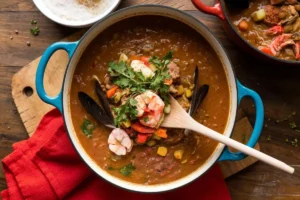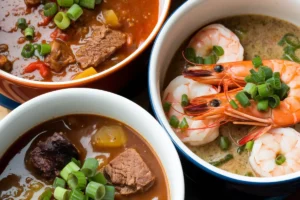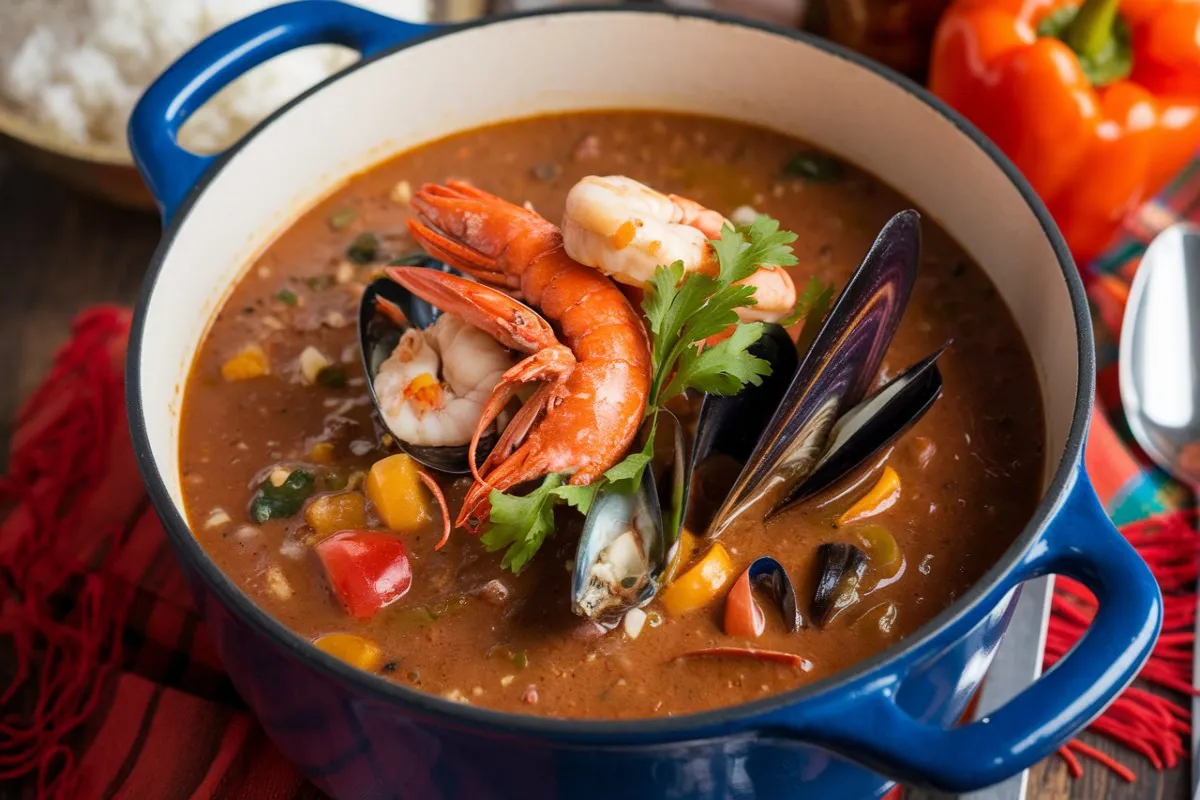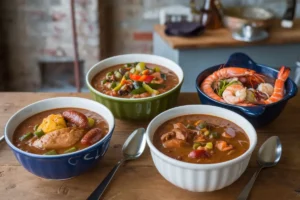Gumbo is an iconic dish rooted in the vibrant culinary traditions of Louisiana, representing a unique fusion of Cajun and Creole cultures. Known for its rich, hearty textures and bold flavors, gumbo is more than just food—it’s a reflection of the diverse history of the region. There are three main types of gumbo that stand out: Seafood Gumbo, Chicken and Sausage Gumbo, and Gumbo Z’herbes. Each type offers its own distinct flavor profile, ingredients, and preparation techniques, making gumbo a versatile and beloved dish.
Gumbo’s origins are as complex as its flavors, blending French, Spanish, African, and Native American influences. The dish typically revolves around three key elements: a rich roux base, the “holy trinity” of vegetables (onions, bell peppers, and celery), and a thickening agent like okra or filé powder. Regional variations, such as the use of tomatoes in Creole vs. Cajun Cuisine, influence the overall taste and appearance of the gumbo. For more on these regional distinctions, you can explore further here.
The Three Types of Gumbo
1. Seafood Gumbo
Seafood gumbo is one of the most beloved versions of this dish, particularly along the Gulf Coast. This gumbo typically features a mix of fresh shrimp, crab, and oysters, combined with a flavorful seafood stock that enriches the dish. A dark roux is often used to add depth, while okra or filé powder acts as a thickening agent, giving the gumbo its signature consistency.
- Key Ingredients:
- Shrimp, crab, oysters
- Seafood stock
- Dark roux
- Okra or filé powder
- Preparation Tips:
- Start by making a dark roux by slowly cooking flour and fat (oil or butter) until it reaches a deep brown color. This forms the flavor base of the gumbo.
- Use fresh seafood when possible, adding it toward the end of the cooking process to prevent overcooking.
- Season with Cajun spices, such as cayenne pepper, paprika, and thyme, to enhance the dish’s flavor.
- Regional Variations:
- Creole versions often incorporate tomatoes, adding a slight acidity and complexity to the gumbo, whereas Cajun versions tend to avoid tomatoes and focus more on a smoky flavor.
To learn more about making the perfect roux, check out this comprehensive guide on How to Make a Perfect Roux.
2. Chicken and Sausage Gumbo
Chicken and sausage gumbo is a hearty dish that combines tender chicken with smoky andouille sausage. This type of gumbo typically uses a dark roux as its base, creating a robust and flavorful foundation. The holy trinity of vegetables—onions, bell peppers, and celery—adds depth, while seasonings like garlic, bay leaves, and Cajun spices bring everything together.
- Key Ingredients:
- Chicken (often thighs or breasts)
- Andouille sausage
- Dark roux
- Bell peppers, onions, and celery
- Preparation Tips:
- Brown the sausage first in a skillet to render its fat, which enhances the overall flavor of the gumbo.
- Cook the roux slowly, stirring constantly until it reaches a deep, chocolate brown. This step is crucial for developing the dish’s signature flavor.
- Season each layer of ingredients as you go, ensuring that every component is well-flavored.
- Regional Variations:
- Typically, Cajun chicken and sausage gumbo does not include tomatoes, focusing instead on the smoky flavor of the sausage and the rich, dark roux.
- Some variations might include okra or filé powder, but these are not always necessary.
3. Gumbo Z’herbes
Gumbo Z’herbes, also known as “green gumbo,” is a unique variation often prepared during Lent, when meat consumption is restricted. This gumbo features an array of green leafy vegetables, such as collard greens, mustard greens, and spinach, and is traditionally a vegetarian dish, although some versions include smoked meats for added flavor.
- Key Ingredients:
- A variety of leafy greens: collard greens, mustard greens, spinach, etc.
- Dark roux or filé powder
- Garlic, onions, and other herbs for flavor
- Preparation Tips:
- The greens are cooked down with the roux or filé powder, which not only thickens the gumbo but also adds a rich, earthy flavor.
- Season generously with herbs and spices to enhance the natural flavors of the greens.
- Smoked sausage or ham can be added to the gumbo, particularly in non-Lenten versions, to provide a savory depth.
- Regional Variations:
- Some families add a bit of smoked sausage or ham to their Gumbo Z’herbes for additional flavor, especially outside of Lent.
- The choice of greens can vary widely, with some recipes calling for up to seven different types.
Key Ingredients in Gumbo

Roux is a key element in gumbo, made by cooking equal parts flour and fat (usually oil or butter) until it reaches the desired color. Roux acts as both a thickener and a flavor enhancer, ranging from a light tan to a deep, dark brown depending on the dish.
- Types of Roux:
- Light Roux: Used in lighter dishes; cooked for a short time.
- Medium Roux: Offers a more balanced flavor; cooked until light brown.
- Dark Roux: The most common in gumbo, providing a deep, rich taste; cooked until it reaches a chocolate brown color.
- Tips for Cooking Roux:
- Stir constantly to avoid burning.
- Use a heavy-bottomed pot to maintain even heat distribution.
- Be patient—dark roux takes time but adds an incomparable depth of flavor.
Thickening Agents: Okra, Filé Powder, and Roux
Gumbo relies on specific thickening agents that also add to its unique flavor and texture:
- Okra:
- Adds a slightly viscous texture to gumbo.
- Commonly used in seafood gumbo to add both flavor and body.
- Filé Powder:
- Made from ground sassafras leaves.
- Often added at the end of cooking to prevent the powder from becoming stringy.
- Provides an earthy, herbal flavor that enhances the overall dish.
- Roux:
- Acts as the base for flavor and thickness.
- Essential in achieving the right consistency and taste profile for any gumbo.
Regional Differences and Influences
Frequently Asked Questions
What makes gumbo unique? Gumbo’s uniqueness lies in its combination of diverse cultural influences, its rich use of Cajun and Creole spices, and the thickening agents that define its texture. The blend of seafood, meats, and vegetables, along with the slow cooking of the roux, creates a deep, complex flavor.
What is the difference between gumbo and jambalaya? While both dishes are staples of Louisiana cuisine, they are distinct in preparation. Gumbo is a stew served over rice, with a focus on the rich broth and thickening agents like roux, okra, or filé powder. Jambalaya, on the other hand, is more akin to a paella, with the rice cooked directly into the dish, absorbing the flavors of the meats and seasonings.
Is gumbo supposed to be thick or thin? Gumbo’s consistency varies by type, but it should generally be thick enough to coat the back of a spoon without being overly dense. The use of roux, okra, and filé powder contributes to achieving this balance.
Can gumbo be made without a roux? Yes, certain variations, particularly those thickened with okra or filé powder, may not require a roux. However, the absence of roux changes the flavor profile, as it typically contributes a nutty, rich taste to the gumbo.
How long does gumbo need to simmer? Gumbo should simmer for at least an hour, but longer cooking times (2-3 hours) are often recommended to allow the flavors to meld together. Seafood should be added closer to the end to avoid overcooking.
Cooking Tips and Common Mistakes
Tips for Making Authentic Gumbo
- Be patient with the roux: Cook it slowly to develop the right depth of flavor without burning.
- Layer your seasonings: Season each step of the cooking process—this layering technique builds complexity in the final dish.
- Add seafood last: If making seafood gumbo, add shrimp, crab, and other delicate ingredients near the end to keep them tender.
Common Mistakes to Avoid
- Burning the Roux: Burned roux will ruin the flavor of your gumbo. Stir constantly and adjust the heat as needed.
- Overcooking Seafood: Adding seafood too early can result in tough, rubbery texture. Instead, add it in the last 10-15 minutes of cooking.
- Not Using Fresh Ingredients: Whenever possible, use fresh ingredients, particularly for seafood, as it greatly impacts the flavor and quality of the dish.

Conclusion
Gumbo is not just a dish—it’s a taste of Louisiana’s cultural history and a celebration of its diverse culinary heritage. From the seafood-rich Seafood Gumbo to the hearty and smoky Chicken and Sausage Gumbo, and the unique, herbaceous Gumbo Z’herbes, each type brings something special to the table. Experimenting with different types allows you to appreciate the versatility of gumbo and bring a piece of Southern tradition into your home. Whether you’re a seasoned cook or new to this classic dish, understanding the basics of roux, ingredients, and regional variations will help you create a memorable gumbo that pays homage to its roots.
For a deeper dive into the history and variations of gumbo, explore this History of Gumbo to better understand how this dish evolved into the beloved comfort food it is today.


